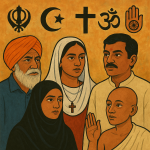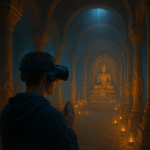Digital Faith Influencers: YouTube, Instagram & Spiritual Branding
In the 21st century, spirituality has found a new pulpit — the digital screen. From YouTube to Instagram, faith leaders, monks, and spiritual teachers are reimagining how devotion, mindfulness, and moral lessons are shared. What once required temple visits or sermons in community halls now reaches millions through a smartphone. This rise of “digital faith influencers” marks a powerful transformation in how religion and spirituality are practiced, understood, and monetized in the age of social media.
The Rise of the Digital Guru
A decade ago, religious influence was largely confined to physical spaces — ashrams, churches, mosques, and temples. Today, however, social media has created a new generation of “digital gurus” who connect with global audiences through videos, reels, and podcasts. These modern faith communicators blend ancient wisdom with modern communication tools, delivering bite-sized lessons on peace, karma, and purpose.
Figures like Gaur Gopal Das, Sadhguru Jaggi Vasudev, Sister Shivani, and Jay Shetty have become global icons, using the internet to discuss not just spirituality but life skills, relationships, and emotional resilience. Their followers are not limited by geography or religion — people from diverse cultures consume and share their messages daily.
Social media has turned the spiritual message into a movement — accessible, interactive, and personal. YouTube channels dedicated to meditation, Bhagavad Gita teachings, or mindfulness now attract millions of subscribers. Instagram reels with short mantras or motivational insights often go viral, reaching younger generations who might never attend a traditional satsang.
YouTube: The Modern Ashram
YouTube has become the digital ashram of the modern world — open 24/7, free of cost, and globally accessible. Faith-based creators use it not just to preach, but to tell stories, explain ancient texts, and address contemporary issues like stress, loneliness, and self-worth.
The platform’s long-form format allows for depth — whether it’s a 20-minute meditation session, a philosophical discussion, or a recording of a spiritual discourse. During the COVID-19 lockdowns, online satsangs and bhajan sessions offered solace to millions confined in their homes. For many, watching their spiritual teachers online became a form of digital worship and community connection.
At the same time, YouTube’s monetization model has given faith influencers financial independence. Through ad revenue, donations, and memberships, many have built sustainable digital ministries. However, this also raises important questions — where does spiritual service end and personal branding begin?
Instagram & the Visual Language of Faith
If YouTube is the modern ashram, Instagram is the temple of inspiration — visual, quick, and emotionally charged. Spiritual influencers on Instagram focus on short videos, motivational quotes, and visual storytelling that blend sacred aesthetics with modern design.
The language of devotion has evolved — now expressed through clean graphics, minimalistic quotes, and symbolic emojis. A reel of a peaceful sunrise with chanting in the background can inspire more reflection than a long sermon. Instagram’s algorithm rewards authenticity and engagement, encouraging spiritual creators to share real-life insights, moments of vulnerability, and behind-the-scenes glimpses of their practice.
Many temples, yoga centers, and spiritual communities also use Instagram to livestream rituals, festivals, and daily prayers — keeping diasporic followers connected to their traditions. The use of hashtags like #DigitalDharma, #MindfulLiving, or #BhaktiVibes has created virtual congregations that transcend geography.
Spiritual Branding: The New Identity of Faith
The rise of social media has blurred the line between personal expression and branding. For faith influencers, this means building an identifiable digital persona — a logo, color theme, tone of communication, and even merchandise. What used to be “preaching” is now “content creation,” and devotion is often expressed through visual aesthetics and emotional storytelling.
This new form of spiritual branding has both positive and controversial aspects. On one hand, it allows teachers to reach millions, especially youth who crave meaning in a chaotic digital world. On the other, it risks turning spirituality into a commodity — where likes and views replace introspection and humility.
Still, when done with sincerity, branding helps spiritual voices stay relevant in a noisy digital space. It ensures that the message of peace and wisdom doesn’t get lost among endless entertainment feeds. For many creators, their online presence is an extension of seva — selfless service — aimed at uplifting others.
Challenges and Ethical Questions
The digital world, though powerful, also poses challenges. Algorithms reward engagement, not necessarily truth. This can pressure spiritual influencers to oversimplify complex teachings or sensationalize content to attract viewers. Additionally, online fame can bring ego, criticism, and misinformation — things true spirituality aims to transcend.
Ethical responsibility is therefore essential. Authentic spiritual influencers emphasize humility, transparency, and accurate interpretation of sacred texts. Many now collaborate with psychologists, educators, and scholars to ensure their guidance is both spiritually sound and psychologically healthy.
A New Age of Global Devotion
Despite its imperfections, the digital revolution has democratized spirituality. No longer limited by caste, geography, or wealth, anyone can access ancient wisdom with a single tap. The screen has become the new shrine, where followers meditate, pray, and seek comfort in times of uncertainty.
Digital faith influencers are reshaping how humanity understands devotion — not as a ritual, but as a lifestyle. They merge ancient truths with modern tools, creating a language of spirituality that resonates with Gen Z and millennials alike. As the world grows more connected yet more anxious, this fusion of technology and transcendence offers hope. The message remains timeless — love, compassion, and awareness — but the medium has evolved. In a world scrolling for meaning, digital faith influencers remind us that enlightenment can, indeed, go viral.
~Religion World Bureau








